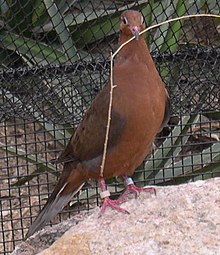Socorro dove
| Socorro dove | |
|---|---|
 |
|
| Socorro dove collecting nesting material Burgers' Zoo, Netherlands |
|
| Scientific classification | |
| Kingdom: | Animalia |
| Phylum: | Chordata |
| Class: | Aves |
| Order: | Columbiformes |
| Family: | Columbidae |
| Genus: | Zenaida |
| Species: | Z. graysoni |
| Binomial name | |
|
Zenaida graysoni Lawrence, 1871 |
|
| Synonyms | |
|
Zenaida macroura graysoni |
|
Zenaida macroura graysoni
The Socorro dove (Zenaida graysoni) is a dove that is extinct in the wild. It was endemic to Socorro Island in the Revillagigedo Islands off the west coast of Mexico. The last sighting in its natural habitat was in 1972. There are not more than 200 and probably fewer than 100 purebred birds in captivity. A reintroduction program is in the early stages of preparation.
It is a close relative of the mourning and eared doves, particularly the former and was at one time considered a subspecies. In captivity, it hybridizes with the former and almost all privately owned birds as well as several of the captive breeding programs are known or strongly suspected to be hybrids. These are excluded from the reintroduction program as there is evidence of unique adaptations in the Socorro species. The scientific name commemorates Zénaïde Laetitia Julie Bonaparte and the American ornithologist and artist Andrew Jackson Grayson.
The Socorro dove is a medium-sized, principally terrestrial dove with long legs for a zenaida dove. It is 26.5–34 cm (10.4–13.4 in) long and weighs 190 g (6.7 oz) on average. In overall color pattern, it agrees with its relatives. It is considered to be a stronger-colored insular representative of the mourning dove. The male is deep cinnamon on its head and underparts, with an ear streak like its relatives. The nape is blue-grey and the neck has an iridescent pink patch, most prominent after moult. The upperparts are rufous brown. Female and juvenile coloration is slightly duller. The most conspicuous differences from the mourning dove – darker coloration and more well-developed feet – were useful amid the dark lava rock and the shady forests of its island home, where native mammalian predators were absent but constant threats from red-tailed hawks and great frigatebirds were present. The advertising call begins with a disyllabic coo, followed by three single calls, and ends with another disyllabic coo: "Coo-oo, OO, OO, OO, Coo-oo". Each of these 5 elements takes a little less than one second.
...
Wikipedia

